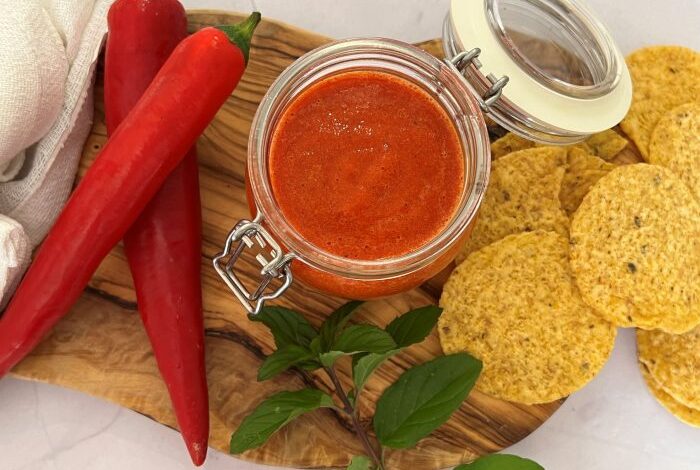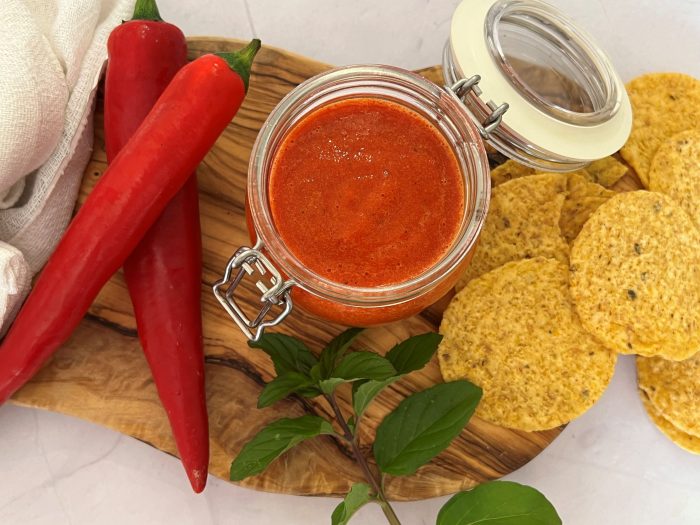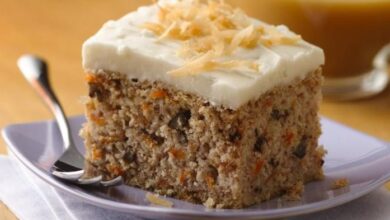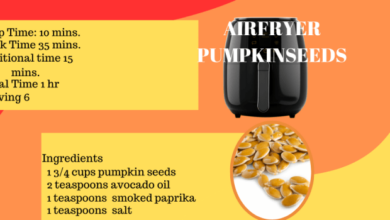
Easy Blender Red Pepper Sauce: A Spicy Homemade Delight
Easy Blender Red Pepper Sauce: A Spicy Homemade Delight. Who doesn’t love a good red pepper sauce? It’s a versatile condiment that can add a kick to any dish, from tacos and eggs to pizza and pasta. But making your own red pepper sauce can be a daunting task, right?
Wrong! This easy blender recipe is a game-changer, allowing you to whip up a delicious and customizable sauce in minutes.
With just a few simple ingredients and your trusty blender, you can create a sauce that’s perfect for your taste buds. Whether you prefer a mild and sweet sauce or a fiery and intense one, this recipe can be adapted to your liking.
We’ll explore the history of red pepper sauce, its health benefits, and some variations you can try. So, get ready to unleash your inner chef and dive into the world of homemade red pepper sauce!
Introduction to Red Pepper Sauce

Red pepper sauce, a fiery condiment that adds a kick to any dish, has a rich history and diverse range of flavors. Its origins can be traced back to ancient civilizations, where peppers were used for both culinary and medicinal purposes.
Making a simple red pepper sauce in the blender is a breeze! You just toss in some roasted red peppers, a bit of garlic, and maybe some vinegar for tang, and whizz it all up. It’s so versatile, great for dipping, drizzling, or even adding a kick to your favorite dishes.
If you’re looking for something with a bit more sweetness, you can always check out sweet chili thai sauce – it’s a classic for a reason. But if you’re looking for something quick and easy, the red pepper sauce is a great option that you can whip up in minutes.
Today, red pepper sauce is a staple in kitchens around the world, offering a burst of heat and complexity to a wide array of cuisines.Red pepper sauce is made from a variety of peppers, each with its unique characteristics. The level of heat, flavor profile, and color can vary significantly depending on the type of pepper used.
Types of Red Pepper Sauce
The types of peppers used in red pepper sauce influence its flavor and heat.
- Jalapeño Sauce:Made from jalapeño peppers, this sauce offers a moderate heat with a slightly fruity flavor.
- Habanero Sauce:Habanero peppers are known for their intense heat and citrusy flavor, resulting in a sauce that packs a punch.
- Sriracha Sauce:This popular sauce combines the heat of jalapeño peppers with the tanginess of garlic and vinegar, creating a balanced and flavorful condiment.
- Gochujang Sauce:Originating from Korea, this fermented red pepper paste is a complex sauce with a savory, sweet, and spicy flavor profile.
Health Benefits of Red Peppers
Red peppers are not only delicious but also packed with health benefits.
- Rich in Vitamin C:Red peppers are an excellent source of vitamin C, an antioxidant that supports immune function and collagen production.
- Anti-inflammatory Properties:Capsaicin, the compound that gives peppers their heat, has been shown to have anti-inflammatory properties.
- May Improve Heart Health:Some studies suggest that capsaicin may help lower blood pressure and improve cholesterol levels.
Red Pepper Sauce in Cuisines Around the World
Red pepper sauce is a versatile condiment that is used in a wide range of cuisines.
- Mexican Cuisine:Red pepper sauces, such as salsa roja, are essential ingredients in Mexican dishes, adding heat and depth of flavor to tacos, enchiladas, and burritos.
- Southeast Asian Cuisine:Sriracha sauce is a popular condiment in Southeast Asian cuisine, often used to add a kick to noodles, stir-fries, and dipping sauces.
- American Cuisine:Red pepper sauces, such as hot sauce, are a staple in American kitchens, adding heat and flavor to burgers, wings, and other dishes.
Easy Blender Red Pepper Sauce Recipe
This recipe for easy red pepper sauce is a simple and versatile way to add a burst of flavor to your dishes. It’s made with just a few ingredients and can be customized to your taste. Whether you’re looking for a mild sauce to drizzle over your eggs or a spicy kick for your tacos, this recipe is a great starting point.
Ingredients and Quantities
The ingredients for this red pepper sauce are readily available and can be found in most grocery stores. The quantities provided below are for a small batch of sauce, but you can easily double or triple the recipe to make more.
| Ingredient | Quantity |
|---|---|
| Red bell peppers | 2 medium |
| Jalapeno peppers | 1-2, depending on desired heat |
| Garlic cloves | 2-3 |
| White vinegar | 1/4 cup |
| Salt | 1/2 teaspoon |
| Black pepper | 1/4 teaspoon |
| Sugar | 1 tablespoon (optional) |
Steps for Making Easy Red Pepper Sauce
This recipe is very easy to follow and can be made in just a few minutes. Here are the detailed steps:
- Prepare the ingredients:Wash and chop the red bell peppers and jalapeno peppers. Peel and chop the garlic cloves.
- Blend the ingredients:Add the chopped peppers, garlic, vinegar, salt, pepper, and sugar (if using) to a blender. Blend on high speed until the mixture is smooth and consistent.
- Adjust consistency and taste:If the sauce is too thick, add a little more vinegar. If it’s too thin, let it sit for a few minutes to allow the peppers to release more moisture. Taste the sauce and adjust the seasoning as needed.
- Store the sauce:Transfer the sauce to a clean jar or container and store it in the refrigerator for up to 2 weeks.
I love how easy it is to whip up a batch of red pepper sauce in the blender. It’s so versatile, perfect for adding a kick to everything from tacos to scrambled eggs. And if you’re looking for a fun side dish to pair with your spicy sauce, I highly recommend trying these spicy pickled green beans.
The tangy, crunchy beans are the perfect counterpoint to the heat of the red pepper sauce. Plus, they’re so easy to make! Just remember to let the sauce cool completely before storing it, as it can get a bit hot when it’s fresh out of the blender.
Blending Time and Consistency, Easy blender red pepper sauce
The blending time for this sauce will vary depending on the power of your blender and the desired consistency. You can expect to blend for approximately 1-2 minutes until the sauce is smooth and free of any chunks.
Important Note:The consistency of the sauce will also depend on the type of peppers used. If you use a lot of jalapeno peppers, the sauce will be thicker due to the higher water content.
Sometimes the simplest things are the best, and that’s definitely true for this easy blender red pepper sauce. It’s perfect for adding a touch of heat and sweetness to any dish, but it’s especially delicious on grilled salmon. Speaking of grilled salmon, have you tried Anne’s fabulous grilled salmon ?
It’s a recipe that’s sure to impress, and the red pepper sauce is the perfect complement. So, if you’re looking for a quick and easy way to elevate your next meal, give this red pepper sauce a try!
Variations and Flavor Profiles
The beauty of homemade red pepper sauce lies in its versatility. You can easily adjust the spice level, add different flavors, and experiment with various ingredients to create your own unique sauce. By understanding the role of different ingredients, you can tailor the flavor profile to suit your taste preferences and culinary creations.
Exploring Flavor Variations
Adding different ingredients to your red pepper sauce can significantly alter its flavor profile. Consider these options:
Garlic and Onion
Garlic and onion are classic additions that impart a savory and pungent flavor. Adding a clove of garlic or a small piece of onion to the blender can enhance the depth of flavor. For a more pronounced garlic or onion flavor, you can sauté these ingredients before blending them into the sauce.
Vinegar
Vinegar adds a tangy and acidic note, balancing the sweetness of the peppers and enhancing the overall flavor. Apple cider vinegar, white vinegar, or red wine vinegar are all suitable options. You can adjust the amount of vinegar to your preference, starting with a tablespoon and increasing it gradually until you achieve the desired tanginess.
Other Ingredients
You can also explore other flavor combinations by adding ingredients like:* Citrus:A squeeze of lemon or lime juice can add a bright and refreshing touch.
Herbs
Fresh herbs like cilantro, parsley, or basil can add a touch of freshness and complexity.
Spices
Experiment with spices like cumin, paprika, or chili powder to add warmth and depth.
Flavor Profile Table
The following table showcases different flavor profiles and their corresponding ingredients:| Flavor Profile | Ingredients ||—|—|| Classic Spicy| Red peppers, vinegar, salt || Savory Garlic| Red peppers, vinegar, salt, garlic || Sweet and Smoky| Red peppers, vinegar, salt, smoked paprika || Tangy and Bright| Red peppers, vinegar, salt, lemon juice || Fresh and Herbal| Red peppers, vinegar, salt, cilantro || Spicy and Fruity| Red peppers, vinegar, salt, mango || Fiery and Complex| Red peppers, vinegar, salt, habanero peppers |
Serving Suggestions and Applications: Easy Blender Red Pepper Sauce
This easy red pepper sauce is incredibly versatile and can be used in a variety of ways to add a delicious kick to your dishes. It’s perfect for adding a touch of heat and flavor to everything from simple snacks to elaborate meals.
Uses in Various Cuisines
The versatility of red pepper sauce extends to various culinary traditions.
- Mexican:Incorporate the sauce into your favorite Mexican dishes like tacos, burritos, and enchiladas. The sauce complements the bold flavors of Mexican cuisine and adds a fiery touch to your meals.
- Asian:The sauce can be used in Asian dishes, adding a spicy dimension to stir-fries, noodles, and rice dishes. Think of it as a fiery complement to the sweet and savory flavors of Asian cuisine.
- American:Use the sauce as a topping for burgers, hot dogs, sandwiches, and even as a marinade for grilled chicken or fish. It’s a great way to add a burst of flavor and heat to classic American comfort food.
Serving Suggestions
The red pepper sauce can be used in many ways to elevate your dishes.
- Topping:Drizzle the sauce over tacos, nachos, pizzas, or grilled meats for a fiery kick.
- Marinade:Marinate chicken, fish, or tofu in the sauce for a flavorful and spicy bite. The sauce tenderizes the meat while infusing it with bold flavors.
- Dipping Sauce:Serve the sauce as a dipping sauce for chicken wings, fries, or vegetables. Its fiery flavor will add a satisfying kick to your snacks.
Storage and Shelf Life
Proper storage is crucial to ensure your homemade red pepper sauce maintains its vibrant flavor and texture. With a little care, you can enjoy your creation for weeks or even months.
Storage Methods
Storing red pepper sauce correctly is vital to preserve its quality. Here’s a breakdown of the best practices:
- Refrigeration:The refrigerator is the ideal storage environment for homemade red pepper sauce. The cool, consistent temperature helps slow down the oxidation process, preserving the sauce’s flavor and freshness.
- Airtight Containers:Opt for airtight containers made of glass or food-grade plastic. These containers prevent air exposure, which can lead to oxidation and spoilage.
Storage Containers
The right container is essential for maintaining the quality of your red pepper sauce.
- Glass Jars:Glass jars are a popular choice for storing red pepper sauce. They are non-reactive, durable, and allow you to easily see the sauce’s color and consistency.
- Food-Grade Plastic Containers:Food-grade plastic containers are another viable option. They are lightweight, shatter-resistant, and often come in various sizes. Ensure the container is BPA-free for safety.
Temperature Recommendations
Maintaining the right temperature is key to extending the shelf life of your red pepper sauce.
- Refrigerator:Store your red pepper sauce in the refrigerator at a temperature between 35°F and 40°F (1.7°C and 4.4°C). This temperature range effectively inhibits bacterial growth and preserves the sauce’s freshness.
Shelf Life
Homemade red pepper sauce, when stored correctly, can last for a considerable period.
- Refrigerated:Properly stored in the refrigerator, your red pepper sauce can last for several months, often up to 6 months or even longer. The exact shelf life depends on the ingredients used and the specific storage conditions.






